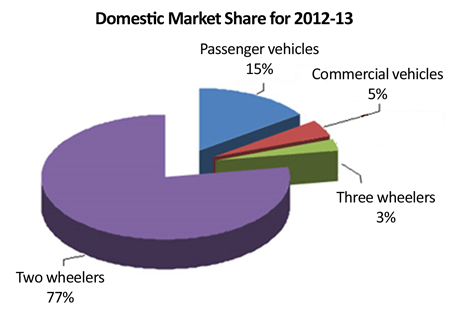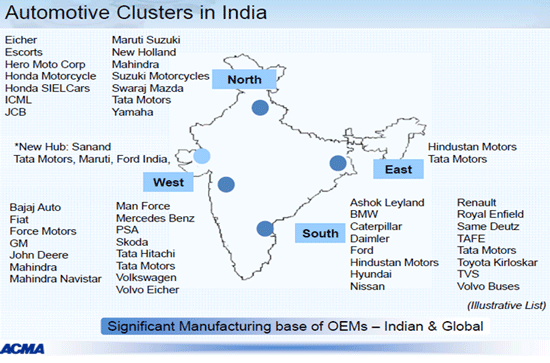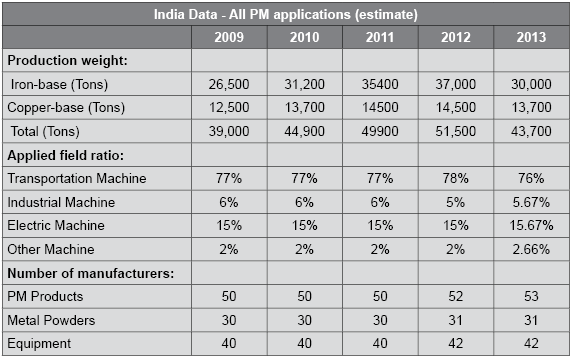PM-14 India report: Powder Metallurgy in the automotive and engineering industries
PM in the automotive industry
A presentation entitled ‘Global overview of PM applications in the automotive industry’ was given by Eckart Schneider of Höganäs AB, Sweden. During the presentation particular reference was made to components used in engine transmissions and body/chassis systems. Potential applications for conversion from other processes to PM were also discussed.
Schneider stated that according to LMC 2013 data it is expected that global automotive production will increase from 83 million in 2013 to around 116 million by 2020, with growth dominated by China (22.5 million to 35 million).
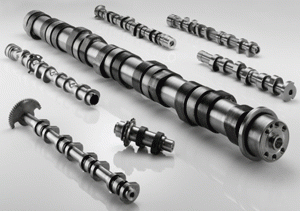
cam shafts (Courtesy Eckart Schneider, Höganäs,
Sweden)
As well as the usual components used in engines and transmissions there is an increasing trend to use assembled cam shafts, with even truck manufacturers considering this option, stated Schneider (Fig. 1). The Variable Valve Timing (VVT) components used in hydraulic systems of gasoline engines are now finding applications in diesel engines and also in inlet and exhausts of small engines (for example the Ford Fox 1.0L – 3cyl.). New gear-to-gear timing and weight balancing systems are also being developed, added Schneider.
The author stated, however, that PM synchronizer rings as well as synchronizer hubs are likely to be at risk due to competition with sheet metal forming technology. Synchronizing sleeves and synchronizing cones as well as transmission gears are though being developed for PM.
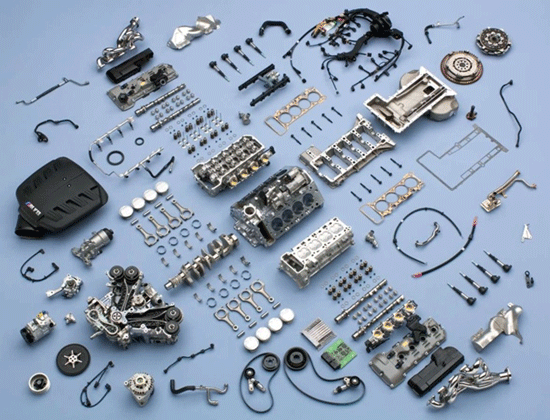
Fig. 2 There are many applications for PM in automotive engines (Courtesy Eckart Schneider, Höganäs, Sweden)
As regards automatic transmission systems, components such as torque converter hubs, thrust/ pressure plates, planetary carriers (sinter brazed), and an increased number of gears are required. PM components in hydraulic systems are being used in g-rotor pump / internal gear pump, external gear pump, pendulum-slider pump, vane type pump and bi-dynamical pendulum-slider pumps.
The body/ chasis applications for PM include shock absorber parts, rear mirror bosses (including rain sensor fixtures), ABS sensor rings, parts for steering column adjustment and parts for electric power steering (EPS), stated Schneider.
The future global market share of hybrid and electric vehicles is difficult to predict. According to Schneider its growth will be dependent on the availability of fossil fuels, but is expected to be more than 20% in 2020. PM technology can have a large share of the new electric drive applications, claimed Schneider. Innovative EV transmission with PM gears are being developed (Vicura, Swepart & Höganäs AB) for improved weight and NVH characteristics he stated.
Schneider added that PM technology can be used to manufacture spur gears, helical gears and can be used in several electro magnetic applications. In torque management systems PM can be used in adjusting discs. In engine downsizing scenarios, Schneider added that turbo charger adjusting rings and vanes offer potential. Light weight differentials are also being developed, stated Schneider, using PM planet gears and differential ring gears.
The Indian PM industry
An overview of India’s PM industry was presented by N L Chandrachud, previously of GKN Sintered Products, Pune, and this year’s recipient of the FPMAI award, in his talk entitled ‘A review of PM in Indian industry, opportunities and challenges’.
Currently the PM parts produced in India, stated Chandrachud, include self lubricating bushes, structural metallic components, hardmetals, carbide tools, ceramic and diamond tools, metal injection moulded parts, electrical contacts, metallic filters, sintered metallic and ceramic magnets and parts for aerospace and defence applications. Broadly the sectors which these are supplied to are automotive, air compressors and industrial applications, power tools, household applications, defence, aerospace and nuclear applications, added Chandrachud.
During 2012-2013 approximately 15.7 million motorcycles and 3.13 million cars, utility vehicles and vans were produced in India. Chandrachud stated that over 30 global OEMs and Tier 1 suppliers source PM components from India, highlighting the fact that Indian PM components are already driven on international roads. The production and distribution of PM components in different sectors is shown in Table 1.
In summarising India’s PM industry, Chandrachud noted that a number of companies are using multi platen advance CNC compaction presses typically up to 500 Tons. Almost all use continuous mesh belt sintering furnaces and a few have one metre belt widths more typically for sintering up to 1150 C. There are a couple of in-line sinter hardening units and high tonnage (500-600 Tons) hydraulic sizing presses for high precision parts are used. Machining facilities exist in house in some cases, but more typically at a vendor base. Secondary processes like steam treatment, conventional HT processes, ion / gas nitriding, induction hardening, etc., are employed where these are needed.
While almost all conventional medium level PM parts used in automobiles are currently being produced in the country, some attempts are also being made to produce the next level components such as VVT parts, cam lobes, high strength speed gears, Powder Forged parts such as connecting rods, synchro rings, stainless steel parts for exhaust systems, EGS, turbo chargers etc., added Chandrachud.
Development in high precision advanced bearings for e-motors, fan cooling, transmissions and other critical applications are desired. The future developments in PM parts and technologies required for these are discussed such as those for, aluminium parts, MIM parts, sintered and non sintered SMCs, powder forged components etc.
In identifying the main requirements for growth in the Indian PM industry, Chandrachud stated that while there are a number of established applications for PM in the automotive sector in specific areas of engine design, transmission etc., the key to growth in the coming decade will be further technology developments and adaptation. Further advancement is necessary in compaction technology with improved powder lubrication mixes coupled with high temperature sintering. SMC, MIM, Powder Forging, aluminium PM were all identified as further areas for development.
“Industry needs to work with PMAI for development of technical manpower at academic institutions. Industry also needs to work with PMAI to improve awareness at OEMs with a ‘Think PM’ and ‘Design for PM’ approach,” concluded Chandrachud.



